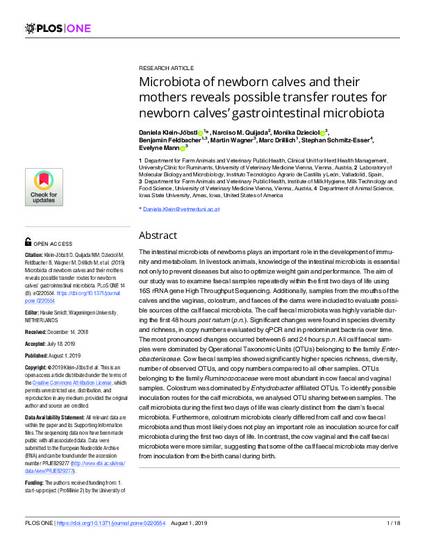
The intestinal microbiota of newborns plays an important role in the development of immunity and metabolism. In livestock animals, knowledge of the intestinal microbiota is essential not only to prevent diseases but also to optimize weight gain and performance. The aim of our study was to examine faecal samples repeatedly within the first two days of life using 16S rRNA gene High Throughput Sequencing. Additionally, samples from the mouths of the calves and the vaginas, colostrum, and faeces of the dams were included to evaluate possible sources of the calf faecal microbiota. The calf faecal microbiota was highly variable during the first 48 hours post natum (p.n.). Significant changes were found in species diversity and richness, in copy numbers evaluated by qPCR and in predominant bacteria over time. The most pronounced changes occurred between 6 and 24 hours p.n. All calf faecal samples were dominated by Operational Taxonomic Units (OTUs) belonging to the family Enterobacteriaceae. Cow faecal samples showed significantly higher species richness, diversity, number of observed OTUs, and copy numbers compared to all other samples. OTUs belonging to the family Ruminococcaceae were most abundant in cow faecal and vaginal samples. Colostrum was dominated by Enhydrobacter affiliated OTUs. To identify possible inoculation routes for the calf microbiota, we analysed OTU sharing between samples. The calf microbiota during the first two days of life was clearly distinct from the dam’s faecal microbiota. Furthermore, colostrum microbiota clearly differed from calf and cow faecal microbiota and thus most likely does not play an important role as inoculation source for calf microbiota during the first two days of life. In contrast, the cow vaginal and the calf faecal microbiota were more similar, suggesting that some of the calf faecal microbiota may derive from inoculation from the birth canal during birth.
Available at: http://works.bepress.com/stephan-schmitz-esser/37/

This article is published as Klein-Jöbstl D, Quijada NM, Dzieciol M, Feldbacher B, Wagner M, Drillich M, et al. (2019) Microbiota of newborn calves and their mothers reveals possible transfer routes for newborn calves’ gastrointestinal microbiota. PLoS ONE 14(8): e0220554. doi: 10.1371/journal.pone.0220554.